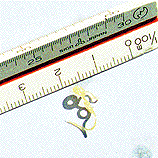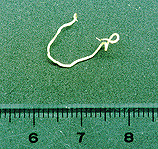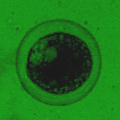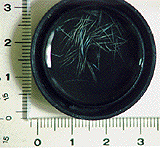There are many reptilian nematodes. It is not certain how many nematodes can infect with tortoises. But
from our point of view nematodes are not so dangerous for tortoises, compareing with the protozoan parasites.
Pathological and deleterious effects are not always seen. They are the dioecism, and some reptilian nematodes
can be seen with the naked eye. Maybe almost all the tortoise keepers will see some nematodes in faeces
of their tortoises.
I will introduce some nematodes which tortoise keepers will see often.
 Roundworms (Sulcascaris & Anqusticaecum in chelonians) are very common tortoises parasites.
Roundworms which are parasitic on tortoises, have direct life cycles.
Roundworms (Sulcascaris & Anqusticaecum in chelonians) are very common tortoises parasites.
Roundworms which are parasitic on tortoises, have direct life cycles.
Roundworms are one of the largest nematodes that can be seen by the naked eye as adults.
In usual cases, these parasites remain passive in the gastrointestinal tract, so moderate parasitic loads are not
so much a problem. Healthy and not stressed tortoises can well tolerate this.
A problem may occur with a stressed and not eating tortoise. Roundworms can absorb and steal 40% of the
nutrients from the host tortoise. And this can lead to a secondary malnutrition.
Large parasitic loads can also cause impaction of the gastrointestinal tract, bile ducts, and pancreatic ducts.
 There is another problem with Roundworm infection.
The larvae of the Roundworm sometimes migrate through other organ systems as a part of their life cycles.
And this can cause ulcerative and inflammatory lesions in the lung, trachea, and other parts. Such lesions
can be secondarily infected by some bacteria.
(The Photo is a Roundworm regurgitated by "KUSANAGI". ( a T.Graeca. SCL=11cm ) )
There is another problem with Roundworm infection.
The larvae of the Roundworm sometimes migrate through other organ systems as a part of their life cycles.
And this can cause ulcerative and inflammatory lesions in the lung, trachea, and other parts. Such lesions
can be secondarily infected by some bacteria.
(The Photo is a Roundworm regurgitated by "KUSANAGI". ( a T.Graeca. SCL=11cm ) )
 Diagnosis on microscope examination is usually based on finding thick-walled eggs in the feces sample.
The eggs seem almost like a circle. The photo is a roundworm egg found in a T.graeca's feces.
In heavy infestations cases, adult worms may be passed in feces or may be regurgitated from the mouth
like the case of "Kusanagi" mentioned above.
Adult worms are round, white, and something like a short spaghetti. The size is in the range of 10 - 150mm.
(1/2 inch to 4 - 6 inches)
Diagnosis on microscope examination is usually based on finding thick-walled eggs in the feces sample.
The eggs seem almost like a circle. The photo is a roundworm egg found in a T.graeca's feces.
In heavy infestations cases, adult worms may be passed in feces or may be regurgitated from the mouth
like the case of "Kusanagi" mentioned above.
Adult worms are round, white, and something like a short spaghetti. The size is in the range of 10 - 150mm.
(1/2 inch to 4 - 6 inches)
When roundworm larvaes moves into the lung of a tortoise, we can see the behavior of the tortoise tyring
to regurgitate something. And also occasionally we can see the tortoise breathing with their mouth open when
sleeping.
Treatment consists of giving Fenbendazole at a dosage of 50 - 100 mg/kg orally, once every two weeks for two
to three treatments. This dose rate is just a reference data. Please consult your vet before dosing.
TO TOP OF THE PAGE
 Pinworms (Oxyurus sp.) Pinworms are very common in tortoises. I keep 7 tortoises now, and all of them
have been infected by pinworms. Most were infected from the time I got them.These parasites have a direct
life cycle and are acquired by drinking or eating fecally contaminated food and water.
Pinworms (Oxyurus sp.) Pinworms are very common in tortoises. I keep 7 tortoises now, and all of them
have been infected by pinworms. Most were infected from the time I got them.These parasites have a direct
life cycle and are acquired by drinking or eating fecally contaminated food and water.
The photograph shows some pinworms that had been passed in feces of "KUSANAGI". (a T.Graeca.)
Pinworms usually live in the lower gastrointestinal tract and cause little overt disease. Impactions have
been reported in iguanas and tortoises. It may be difficult for us to know the existence of them, until they
are passed in the feces.
 Diagnosis is based on finding eggs on fecal flotation. Their eggs will need only a few hours to be infectious.
So, at once this worms are observed, you may better think that other tortoises kept together are already infected .
The photograph is a female pinworm carrying eggs in its body.
Treatment consists of giving Panacur (fenbendazole) orally, at a dose of 50 - 100 mg/kg, once every two to
three weeks until negative stools are obtained. This dose rate is just a reference data. Please consult your vet before dosing.
Diagnosis is based on finding eggs on fecal flotation. Their eggs will need only a few hours to be infectious.
So, at once this worms are observed, you may better think that other tortoises kept together are already infected .
The photograph is a female pinworm carrying eggs in its body.
Treatment consists of giving Panacur (fenbendazole) orally, at a dose of 50 - 100 mg/kg, once every two to
three weeks until negative stools are obtained. This dose rate is just a reference data. Please consult your vet before dosing.
TO TOP OF THE PAGE
 Roundworms (Sulcascaris & Anqusticaecum in chelonians) are very common tortoises parasites.
Roundworms which are parasitic on tortoises, have direct life cycles.
Roundworms (Sulcascaris & Anqusticaecum in chelonians) are very common tortoises parasites.
Roundworms which are parasitic on tortoises, have direct life cycles. There is another problem with Roundworm infection.
The larvae of the Roundworm sometimes migrate through other organ systems as a part of their life cycles.
And this can cause ulcerative and inflammatory lesions in the lung, trachea, and other parts. Such lesions
can be secondarily infected by some bacteria.
(The Photo is a Roundworm regurgitated by "KUSANAGI". ( a T.Graeca. SCL=11cm ) )
There is another problem with Roundworm infection.
The larvae of the Roundworm sometimes migrate through other organ systems as a part of their life cycles.
And this can cause ulcerative and inflammatory lesions in the lung, trachea, and other parts. Such lesions
can be secondarily infected by some bacteria.
(The Photo is a Roundworm regurgitated by "KUSANAGI". ( a T.Graeca. SCL=11cm ) )
 Diagnosis on microscope examination is usually based on finding thick-walled eggs in the feces sample.
The eggs seem almost like a circle. The photo is a roundworm egg found in a T.graeca's feces.
In heavy infestations cases, adult worms may be passed in feces or may be regurgitated from the mouth
like the case of "Kusanagi" mentioned above.
Adult worms are round, white, and something like a short spaghetti. The size is in the range of 10 - 150mm.
(1/2 inch to 4 - 6 inches)
Diagnosis on microscope examination is usually based on finding thick-walled eggs in the feces sample.
The eggs seem almost like a circle. The photo is a roundworm egg found in a T.graeca's feces.
In heavy infestations cases, adult worms may be passed in feces or may be regurgitated from the mouth
like the case of "Kusanagi" mentioned above.
Adult worms are round, white, and something like a short spaghetti. The size is in the range of 10 - 150mm.
(1/2 inch to 4 - 6 inches) Pinworms (Oxyurus sp.) Pinworms are very common in tortoises. I keep 7 tortoises now, and all of them
have been infected by pinworms. Most were infected from the time I got them.These parasites have a direct
life cycle and are acquired by drinking or eating fecally contaminated food and water.
Pinworms (Oxyurus sp.) Pinworms are very common in tortoises. I keep 7 tortoises now, and all of them
have been infected by pinworms. Most were infected from the time I got them.These parasites have a direct
life cycle and are acquired by drinking or eating fecally contaminated food and water.  Diagnosis is based on finding eggs on fecal flotation. Their eggs will need only a few hours to be infectious.
So, at once this worms are observed, you may better think that other tortoises kept together are already infected .
The photograph is a female pinworm carrying eggs in its body.
Treatment consists of giving Panacur (fenbendazole) orally, at a dose of 50 - 100 mg/kg, once every two to
three weeks until negative stools are obtained. This dose rate is just a reference data. Please consult your vet before dosing.
Diagnosis is based on finding eggs on fecal flotation. Their eggs will need only a few hours to be infectious.
So, at once this worms are observed, you may better think that other tortoises kept together are already infected .
The photograph is a female pinworm carrying eggs in its body.
Treatment consists of giving Panacur (fenbendazole) orally, at a dose of 50 - 100 mg/kg, once every two to
three weeks until negative stools are obtained. This dose rate is just a reference data. Please consult your vet before dosing.